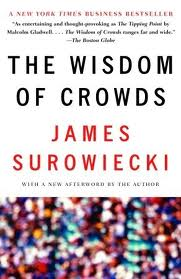What can a one-ton farm animal show us about the power of shared intelligence? Lior Zoref—and his many friends—have an idea.
This week’s New Yorker magazine includes a piece that references Zoref’s TED Talk about the wisdom of crowds. In the presentation, Zoref demonstrates how groups access knowledge in a different way than individuals can. Dramatically, he brings an ox on stage and asks his audience to guess the beast’s weight, posting their responses anonymously on a web page. After the tabulation, estimates range from 308 pounds all the way up to 8,000. No individual hits the target, but as a group they get remarkably close: the average of the guesses taken together is 1792 pounds, just three off the correct weight of 1795 pounds!
With the social media and internet access now available through mobile devices, generating and using such wisdom will only become easier and easier. As Zoref relays, a minister can get help with a Sunday sermon or a frightened mother can get help with diagnosing her children’s mystery illness. One can imagine the principle operating on even larger scales, with municipalities or nations asking for help with their thorniest dilemmas.
I’d love to draw on my students’ group wisdom in the classroom to generate positive differences in the worlds they inhabit. The hook would come easy: we could do our own version of Zoref’s ox by trying to “count” the number of jellybeans in a jar. We’d likely get it close to right, especially if we had a larger number of kids participating. From there, questions would freely flow: How does this work? What does this kind of shared intelligence mean about being human? What does it suggest about how we might live going forward?
Of course, there’s good reason to be cautious too. As with all technologies, some dangers exist. (See the previous post #4, The Om Phone: Technology of Meditation for more on that idea.) Group “wisdom” can descend into mob stupidity. Anonymity in a crowd can provide cover for otherwise outrageous behavior. And the bystander effect (https://en.wikipedia.org/wiki/Bystander_effect) suggests that the likelihood of helping a stranger in trouble goes down in proportion to the number of people witnessing the injustice. Crowds don’t always get it right.
 But there are ways to help make sure they do. James Surowiecki, author of The Wisdom of Crowds, names four characteristics that a crowd needs to achieve its wisest, most creative expression.
But there are ways to help make sure they do. James Surowiecki, author of The Wisdom of Crowds, names four characteristics that a crowd needs to achieve its wisest, most creative expression.
- Diversity. The wider the range of experience, perspective, values, and opinions, the greater the resilience and intelligence. Biological communities demonstrate this dynamic in response to a threat—no surprise it holds here as well.
- Independence. Those in the crowd need to make up their own minds without being pressured by the opinion or input of others—that’s where mob mentality can storm the gates of good intentions.
- Decentralization. Each participant hones in on what matters most to them and draws from his or her own insight and experience.
- Aggregation. All those independent opinion points get refined through a meta-analysis to bring forward the group’s decision.
I’m reminded of Quaker gatherings where the point is, together, to discern God’s will for the group. No voice leads or dominates. Anyone can speak. Comments that seem unrelated often pull together into a larger pattern that no one could have predicted ahead of time. Over time—and sometimes it could be months—the group comes to consensus on a wisdom that no could have found on their own.
The same also seems true for the best improvisational theater, though within a more immediate time frame. A top-notch troupe includes members coming from diverse backgrounds and trainings who have the confidence and groundedness to put their own gifts forward without hesitation. The form or style of play, whether Johnstone’s TheaterGames or long-form improv, for example, provides the “meta” that filters those individual voices into a larger whole. When players lean into their connection with each other, staying attentive for What’s trying to move through us? rather than worrying about Am I doing OK? Or Do they like me?, that’s when the real magic happens. Even better when the audience is a part of the performance, like when the group guesses the ox’s weight. That’s when the jaws drop. That’s the wisdom of the crowd.
What examples of group wisdom have you witnessed? What promise do you think the idea holds? What danger?

